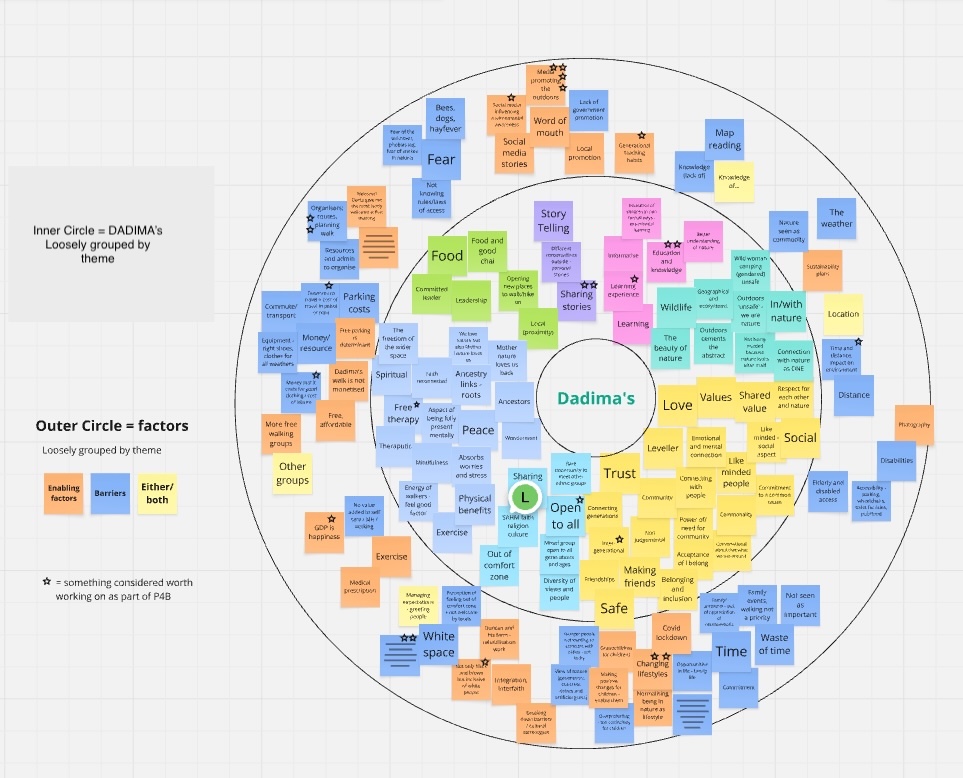Using the Onion Model
The onion diagram is comprised of 3 circles (layers), which represent:
- Centre: the focal issue e.g. staff engagement in biodiversity initiatives
- Inner ring: direct factors e.g. processes, policies, people, access, communications
- Outer ring: indirect factors e.g. wider culture, norms, resource flows, external expectations

Surface Relationships and Influences
Starting with the inner ring and working outwards, encourage your attendees to think of factors they think influence the core concept - either directly or indirectly. Write these factors down on sticky notes, - thereby making it is possible to move these across layers as the discussion develops, or to cluster them within layers of onion. Each sticky note should represent only one factor. Populate the layers as accurately as possible. Consider prompts such as the following to guide participants’ thinking and discussion:
- Power and permission - who can act, and who can’t?
- Knowledge and information - where is it held, and how does it flow?
- Values and attitudes - what assumptions are influencing choices?
Participants may bring unexpected insights. Accept that some may be more emotional or narrative in tone.
The facilitator (or a colleague assisting with the running of the workshop) might want to take notes in addition to the sticky notes, to document emerging themes - i.e. not just the content of the notes, but the conversation around them.
By way of an example of what a completed system map might look like, if for instance the central issue is:
“What influences whether staff take part in biodiversity volunteering activities?”
The core ring might potentially include:
- Awareness of existing volunteering opportunities and how they are communicated within the organisation.
- Consistency of participation across departments, teams, and roles.
- The extent to which volunteering is encouraged, supported, and valued as part of organisational culture.
- Availability of time and manageable workloads that enable staff to participate.
- Clarity about how volunteering connects to performance, wellbeing, and professional development.
- Inclusivity of activities, ensuring that opportunities are accessible and relevant to all staff.
- Understanding of who is invited, allowed, or expected to take part.
- Levels of connection between staff and the concept of biodiversity, and how this relates to their roles.
- Reliance on individual champions or informal networks to sustain engagement.
- Visibility of leadership endorsement and its influence on overall participation.
Whilst within the inner ring, participants might write:
- Time-off not approved by line managers
- No one talks about it in team meetings
- Some teams always get asked, others never do
- There are not regular sessions
- I didn’t know we were allowed to take part
And within the outer ring, factors might include:
- Leadership focuses on net zero targets
- Biodiversity seen as an add-on, not part of work culture
- Initiatives rely on one or two enthusiasts
- Lack of visible support from senior managers
- Company values say ‘inclusive and green’ but not reflected in daily routines
Identify Enablers and Barriers
Invite the group to reflect on what supports action and what holds it back. Use a new colour of notes and/ or you may also prefer to add a separate layer to the ‘onion’ to capture these.
Look for patterns:
- Are some enablers fragile or dependent on individuals?
- Are barriers structural, relational, or perceptual?
- Are there factors that could be either enablers or barriers, depending on context and/ or differing groups of employees?
Some participants may share personal or cultural interpretations of enablers and barriers. This can open deeper understanding of how the organisation works, and for whom.
In this video Lindy Binder reflects on some of the enablers and barriers that emerged from the PLANET4B Systems Mapping workshop:







.svg)


